The bear in the collective imagination
Apennines, myths, bears and men
Bears have been part of human culture since ancient times and are associated with rituals, myths, legends and fairy tales.
They have always stimulated the imagination and fantasy of man, who at different times has portrayed them as deity, hero, ancestor and seducer, but also ferocious beast, demon or tender childhood companion. Retracing this history often means losing your way in a maze of interpretations and metaphors. So here too, our sole purpose is just to provide a number of images and suggestions. Both familiar and at the same time remote, bears have aroused a more contradictory attitude in man than perhaps any other animal. But then again, how could we not be both fascinated and disturbed by the resemblance between the physique and attitudes of bears and man himself? Or faced with their physical strength and endurance? Or a female bear’s deep bond and affection for her children?
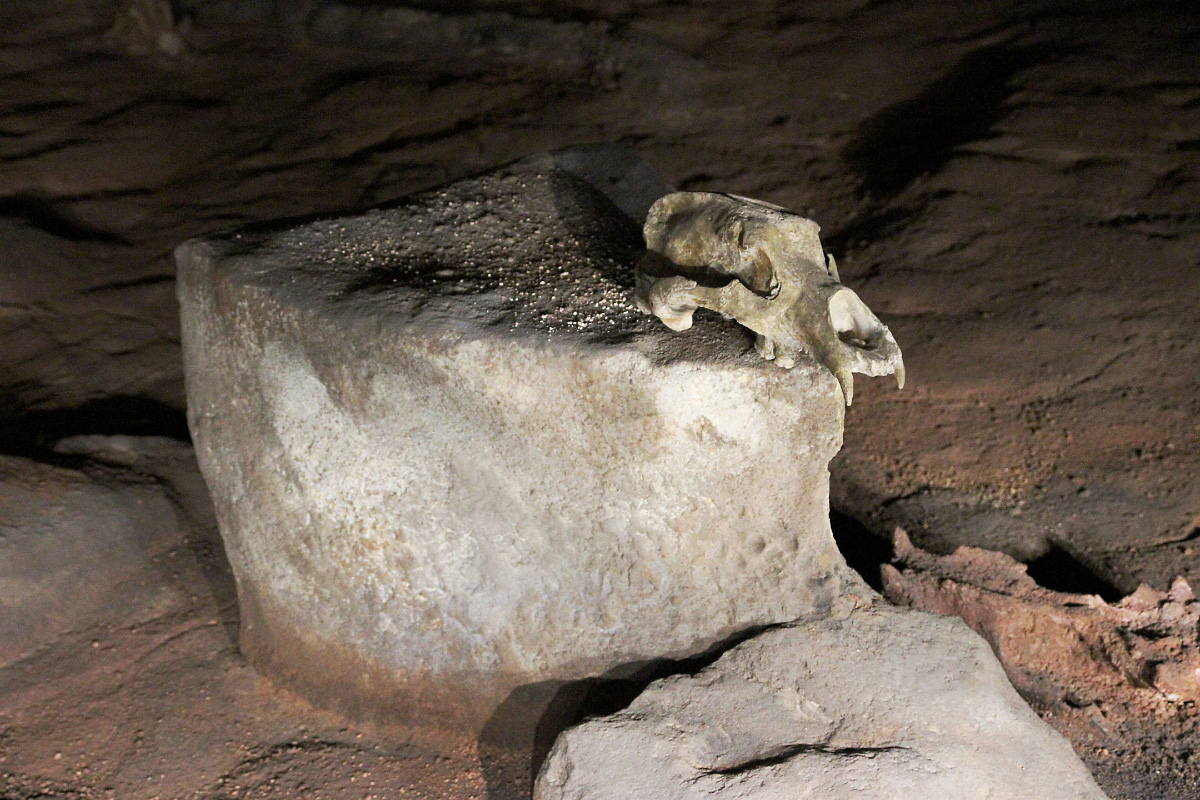
Deliberately positioned skull of Ursus speleaeus in the Chauvet cave – Pont d’Arc, Ardèche, France.
Throughout the ancient and medieval West, there is abundant evidence of a bear cult in Greek and Roman, Germanic and Celtic mythology, with some indications reaching back to prehistoric times.
The most ancient traces of a link between man and bears probably date back to about 80,000 years ago in the Regourdou cave in France, where researchers found the burial sites of a Neanderthal and a bear side by side. From about 30,000 years ago, a growing number of “suspicious” indications have been found in caves shared by humans and bears, in the form of wall paintings of bears, or skulls placed in almost liturgical arrangements. There seems little doubt that bears played a particular role in the palaeolithic bestiary and some authors believe they may also have been an object of worship.
In the myths of Ancient Greece, bears were considered an attribute of certain deities. One of these was Artemis, the goddess protector of animals and hunting, who is represented as a bear together with her priestesses, sometimes known as “little she-bears”. Her very name comes from the Greek word arktos, meaning bear. One of the myths linking Artemis to bears tells of the creation of the constellation Ursa Major. According to one of the many versions, furious with the nymph Callisto for betraying her, Artemis transformed her into a bear and set her hunting dogs on her. The god Zeus took pity on her and decided to save her by transforming her into a constellation.
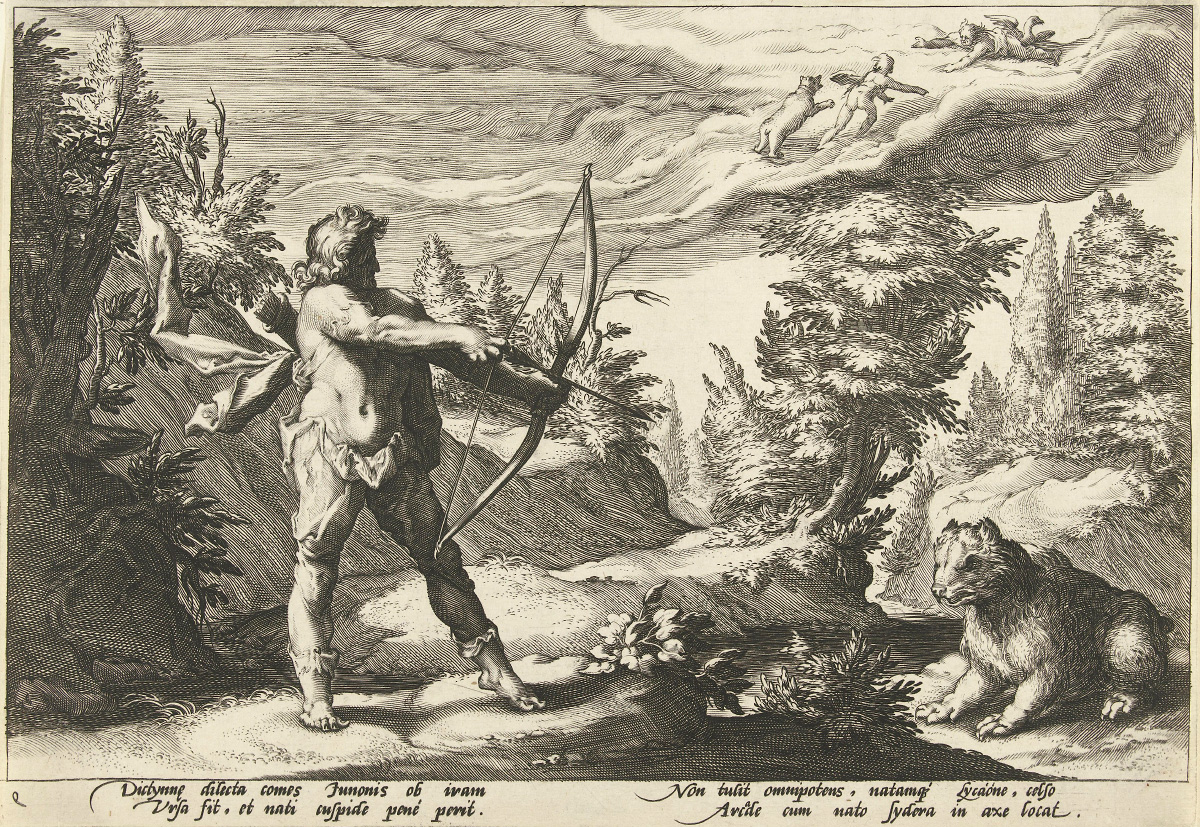
The myth of Callisto: Arcas pulls his bow against his mother transformed into a bear. Engraving by Hendrick Goltzius and Franco Estius, 1590.
In addition to Artemis, Greek mythology also has numerous myths of female bears feeding and raising newborn infants who grow up to become heroes. One example among many is Paris, son of Priam, king of Troy. The myth tells that before his birth, Paris’ mother dreamed of the future destruction of the city of Troy. Shocked by the premonition, his father ordered his servants to kill Paris on Mount Ida. The servants lacked the courage and instead abandoned him on the mountain. He was found by a bear who saved him from the freezing cold and starvation, until shepherds found him and took him in.
Among the ancient Germanic peoples who spread from Scandinavia to most of Europe from the 19th century BC, bears were considered an emblem of strength, courage and invincibility, the totemic animal par excellence. The bear was the king of the animals and the forest, a deity, or at least a creature halfway between the world of men and that of the gods, an ancestor and above all a warrior. As a sign of respect, bears could not be called by their proper name, but only addressed using alternative lexical formulas. Warriors wore amulets made of bear’s teeth, claws and skins to gain strength and courage. Fighting a bear with their bare hands was a test of courage that allowed boys to become adults and gain the repute of a great warrior. Among the most famous warriors were Odin’s soldiers, the berserkir, otherwise known as “werebears”, who drank and ate bear meat and fought imitating the animal’s gait and sounds. These warriors thus acquired the ability to shapeshift into bears, entering a state of “bearness”.
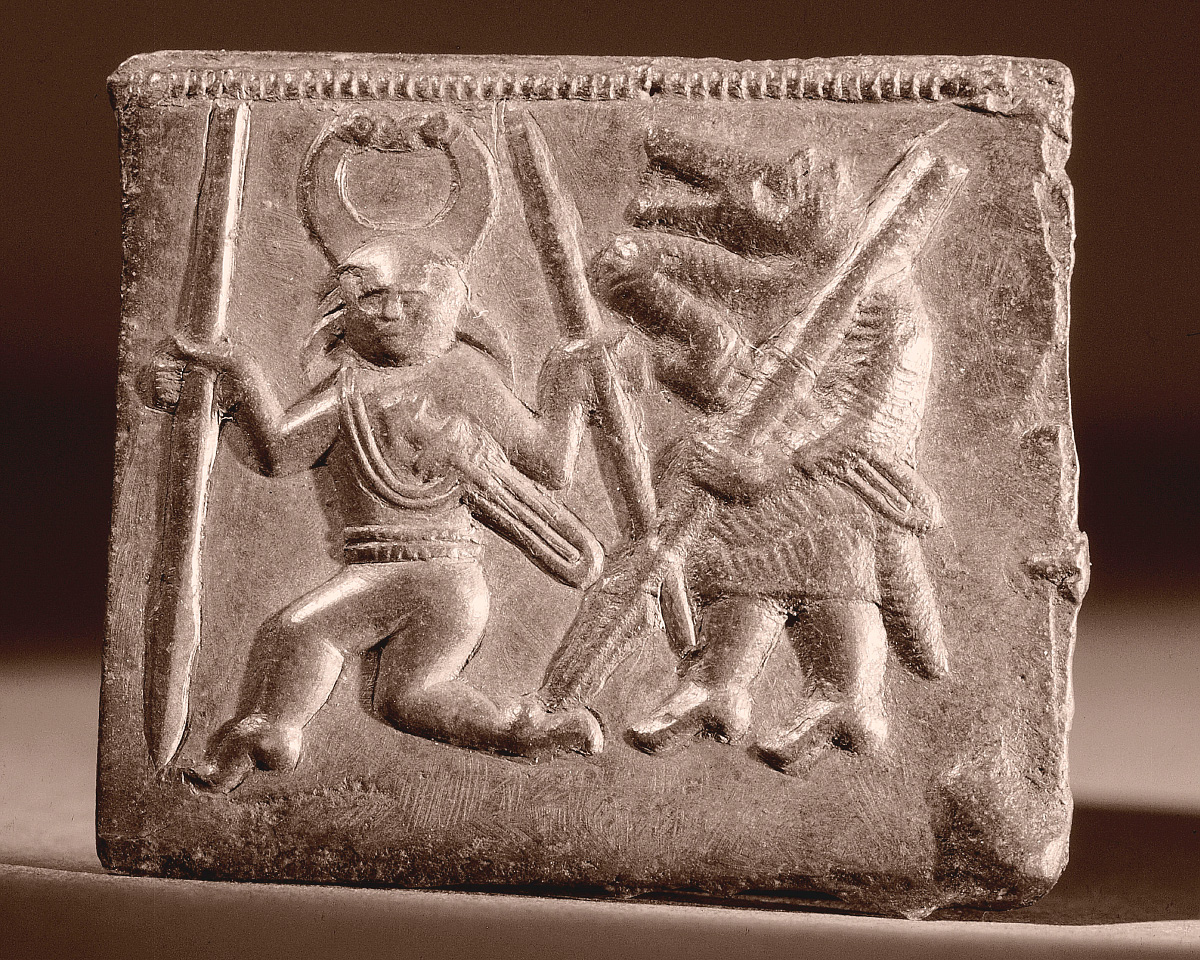
Viking die used to press helmet plates. It depicts a dancing warrior accompanied by a figure halfway between a man and a wolf. Among ancient Germanic peoples, warriors were often given the attributes of bears or other predators.
Among the Celtic peoples distributed over a vast area of Europe from the British Isles to the Danube basin between the 5th and 3rd centuries BC, the bear was a symbol of power, sovereignty and royalty. Many rulers boasted ancestors with bear-like features, or claimed to have been raised by bears. Some only became kings after fighting against a bear. In all cases it was the connection with the bear that made a man worthy of being king. One of the best known is Arthur, described in legend as being able to kill a man with just a simple embrace.
In the Roman world, bears were part of a wilder dimension. They were essentially game to be hunted (to the point of full-scale massacres) and an object of spectacle in circus games, hunts and fights with gladiators. Bear hunting was above all a privilege of emperors and their entourage and, as a sign of both respect and prestige, it was almost always direct “hand-to-paw” combat. Owning a bear was also an attribute of power and only an emperor could have a menagerie with bears. The practice of menageries as the privilege of princes and great lay and ecclesiastical lords continued throughout the Middle Ages. The gift of a bear was a frequent sign of peace or respect between rulers.
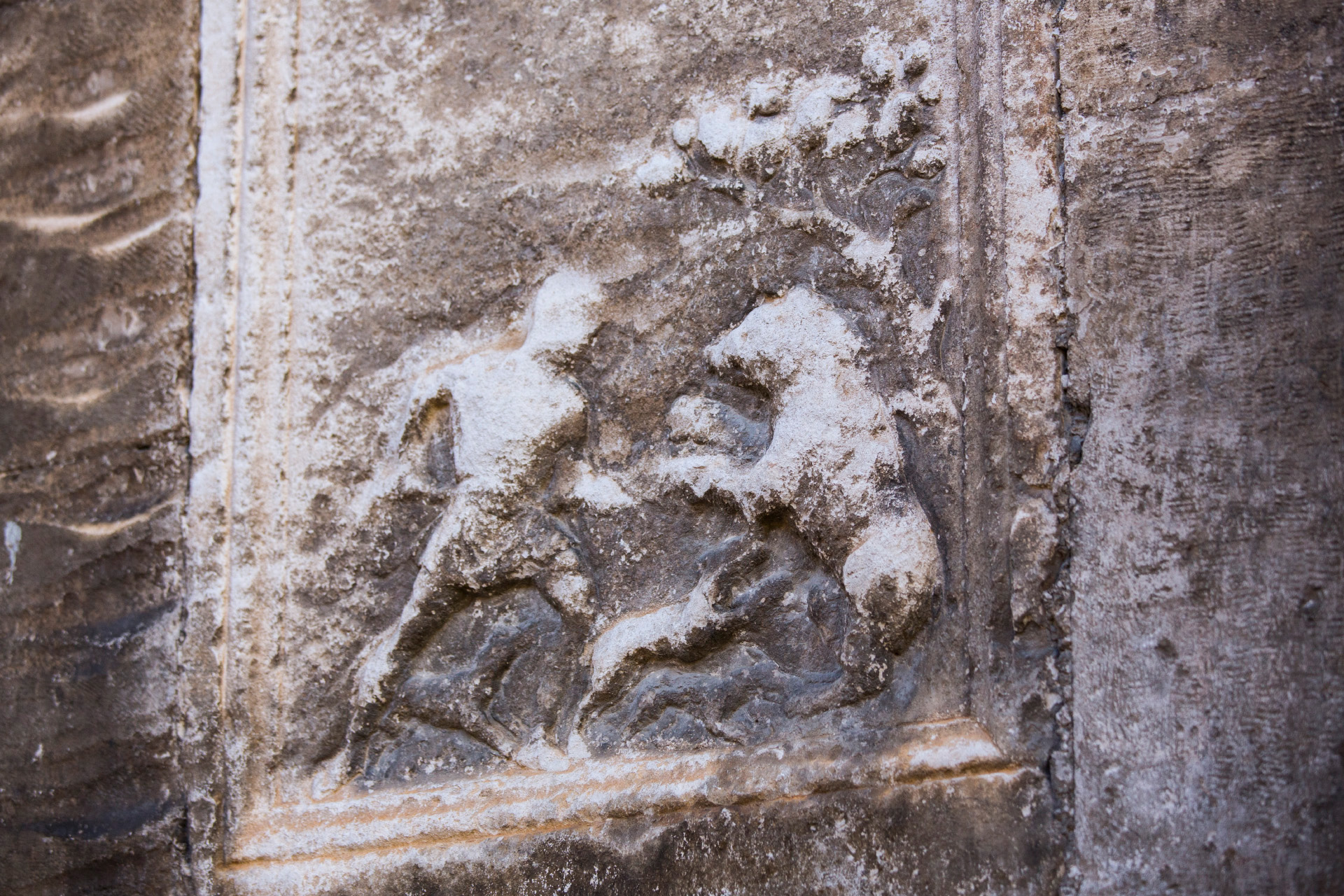
Roman bas-relief depicting a bear hunting scene with spear and hounds, kept in Palazzo Tabassi, Sulmona in the province of L’Aquila.
The resemblance between the physique and behaviour of bears and men has led to their worship and adoration, but also condemnation and persecution.
Greek, Celtic and Germanic mythology also depicted the bear as a lover of maidens and young women, with stories oscillating between the romantic and the violent, more often taking the form of abductions rather than love encounters. During the Middle Ages, beliefs expressing this strong attraction between women, queens and the beast spread throughout Europe. They play heavily on the ambiguity of certain historical characters, such as King Arthur or Tristan, the lovestruck king, considered half man and half bear. Then again, during courting and mating, there is a resemblance between men and bears and it was believed they could even procreate. This kind of myth and legend was also common in Italy. According to legend, the noble Orsini family, that gave the world numerous popes and cardinals, originated from a relationship between a man and a bear. Bears also became a symbol of brute desire and in many festivals, from the Roman lupercalia to medieval festivities associated with carnival and the solstices, “playing the bear” came to mean letting yourself go and indulging in transgressive and “abominable” acts, as they would later be described by the Church.
During the Carolingian era, it was precisely the early medieval Christian Church that declared war on the bear, with the aim of destroying any form of pagan culture, considered an enemy of Christ. Bears were physically persecuted and slaughtered in many regions of Europe and eradicated along with pagan cults. In the late 12th and early 13th centuries, the bear was demonised and transformed into an infernal creature and even an abomination in which animal nature was confused with human nature, an affront to God who had created man in his likeness. In the medieval bestiary, the appellation of “bruin” for the bear lost all real connotations and came to suggest a dark, dirty, hairy and shaggy demonic creature. Bears also became an object of derision and were ridiculed in fables and proverbs, where man portrayed them as vicious and sinful. As many as seven deadly sins are attributed to the bear: pride, avarice, lust, anger, gluttony, envy and sloth.
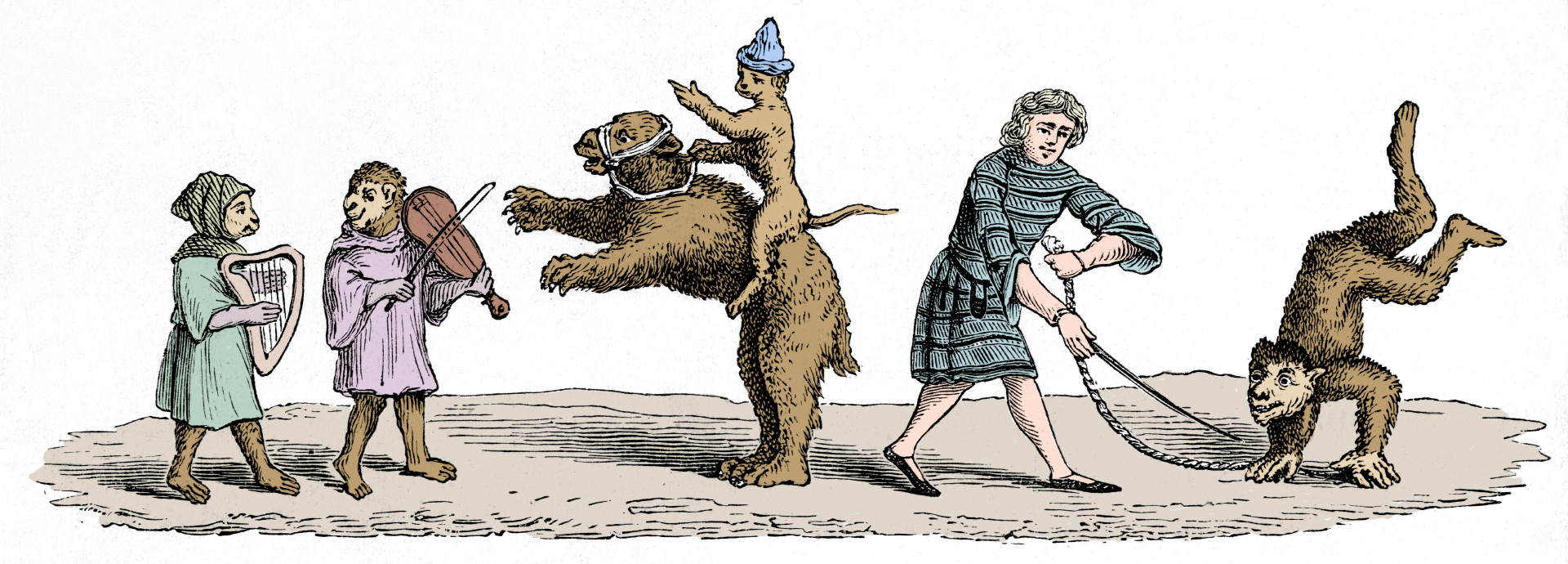
Thirteenth century engraving of a spectacle with a bear and trained monkeys, taken from the “Dictionnaire historique et pittoresque du théâtre […] by Arthur Pougin (1834-1921).
When the figures of saints replaced those of warriors, they were considered the only ones able to redeem bears and convert them to Christianity. Legend has it that Saint Florent of Saumur convinced a bear to guard a flock of sheep, while Saint Romedius tamed the bear that had killed his horse so he could get to Trent to see his friend the bishop.
The long war against the bear continued with modification of the pagan calendars and holidays (many of which were bear-centric) and their transformation into Christian festivals. In the 13th century, bears were dethroned from heraldry and replaced with the lion. They thus ended up losing their regal attribute and were relegated to a wild animal, or a spectacle in squares, where they were muzzled and made to dance or perform acrobatics like a jester.
But the bear never disappeared from man’s imagination and dreams. From the 14th century onwards, romantic legends of bears abducting maidens came back into vogue. Bears gradually re-entered the world of fairy tales with the theme of beauty and the beast, although in many stories they were still ridiculed and depicted as ignorant, melancholic, lazy, stupid or greedy beasts. From Scandinavia to the Mediterranean, there is a boundless wealth of romantic stories about relationships between women and bears and the children born from this union. These tales are populated by children with almost human features, except for thick fur, a bear’s paw, or the ability to speak the language of bears. Even today, there are still some who boast of belonging to a clan of bears and of having had a Jean-de-l’Ours, John the Bear or Gianni Orsino as an ancestor.
In modern times, bears are settling the score by becoming favourite children’s toys, although at the same time they are being marginalised by the world of men.
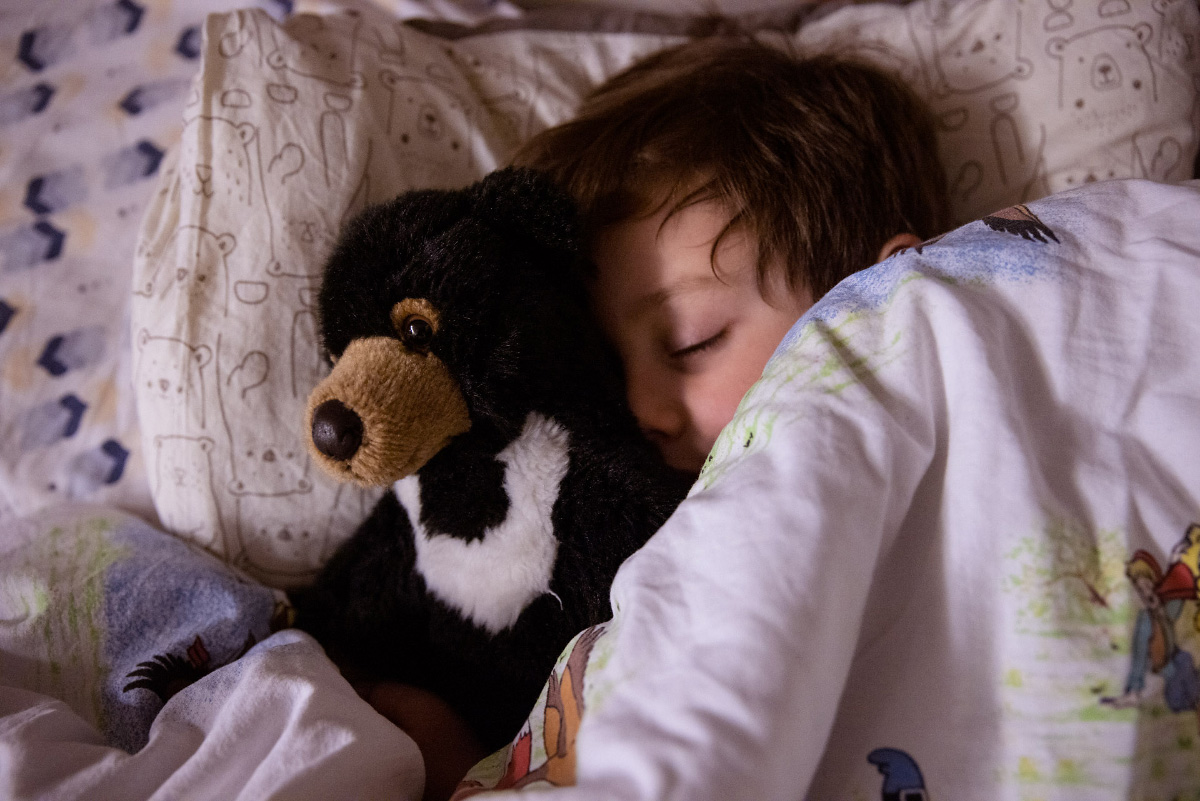
A sleeping child clasps his teddy bear tightly.
Over time, partly as a result of physical and intellectual persecution, bears became increasingly remote and invisible animals, relegated to the mountains and national parks, visible at first hand only in museums, zoos or circuses. But at the same time, they entered the world of childhood, thanks to US President Theodore Roosevelt (1858-1919) and his passion for hunting. It all began when the president decided to spare a black bear cub during a hunting trip, an event reported in all magazines of the time. The media wave led to creation of a soft toy in memory of the episode… and so the teddy bear was born. From the 20th century onwards, the passion for bears as a tender childhood companion exploded. Since then, furry teddy bears have not only populated children’s rooms, but also appeared in cartoons, advertisements and our books. On the other hand, some authors believe it is precisely this process, in parallel with industrialisation, that has contributed to the growing marginalisation of bears, removing them definitively from our everyday lives. Over time, the impetus of industrialisation and depopulation of the countryside led to collapse of the old rural communities and abandonment of their ancient practices and production cycles, breaking the direct link between man and the natural world. Animals were demoted to zoomorphic toys, figures and cartoons, as in Disney, where bears become synonyms for humans and no longer represent their own origins. They wear clothes and lose their wildness. The real animals still exist, but they live in remote or artificial places, such as museums, zoos, films and TV. A rupture has developed between man and nature. They are two worlds that have drifted apart. Nature is distant, an idealised place to seek out, and all the more distant and foreign precisely for that.
Especially in rural cultures, bears have always been a symbol of the cycle of time, the passing of the seasons, death and rebirth and an integral part of many pagan festivals, some of which are still staged today.
Italy is no exception and there is still an echo of the bear cult in many festivals that have maintained certain pagan traits in remembrance or ritual. In ancient times, there was a genuine bear calendar and traces can still be found today. One example is the festival of St. Martin on 11 November. This coincides with the birth of the Saint, known for having subdued a bear to the rank of a mule. But on that same date, countryfolk used to celebrate the moment when bears began to sense the arrival of winter, retiring to their den for two forty-day periods. In farming culture, it was also the moment to bring livestock back to the byre and put the implements to rest. This event was celebrated with violent and transgressive masked festivities and rituals, later abandoned. And this was so for many other autumn festivals that came to be associated with saints who had tamed bears, or had the word bear in their name.
Another example is February 2, also known as Candlemas. This is when Christians celebrate the presentation of Mary in the temple, forty days after the birth of Jesus. But the festival has much older roots. According to the tradition of medieval alpine Europe (but not only), during the night between the first and second day of February, bears wake up from their winter hibernation and observe the sky. If they find it “clear”, they go back to bed, because winter will last forty days more. On the other hand, if the sky is “dark”, then they will come out of their den to announce the beginning of spring. From year to year, this helped farmers remember how to interpret the position of the moon and so to find out if it would be a favourable year (late Easter) or a negative year (early Easter). In the Aosta Valley, it is said that if the weather is fine on the first of February, the feast of Saint Ursus, bears put the straw and hay that will serve as bedding out to dry, certain that winter will last another forty days. In the past, these festivals were also accompanied by dancing and wild games depicting abductions and rape by men masquerading as bears.
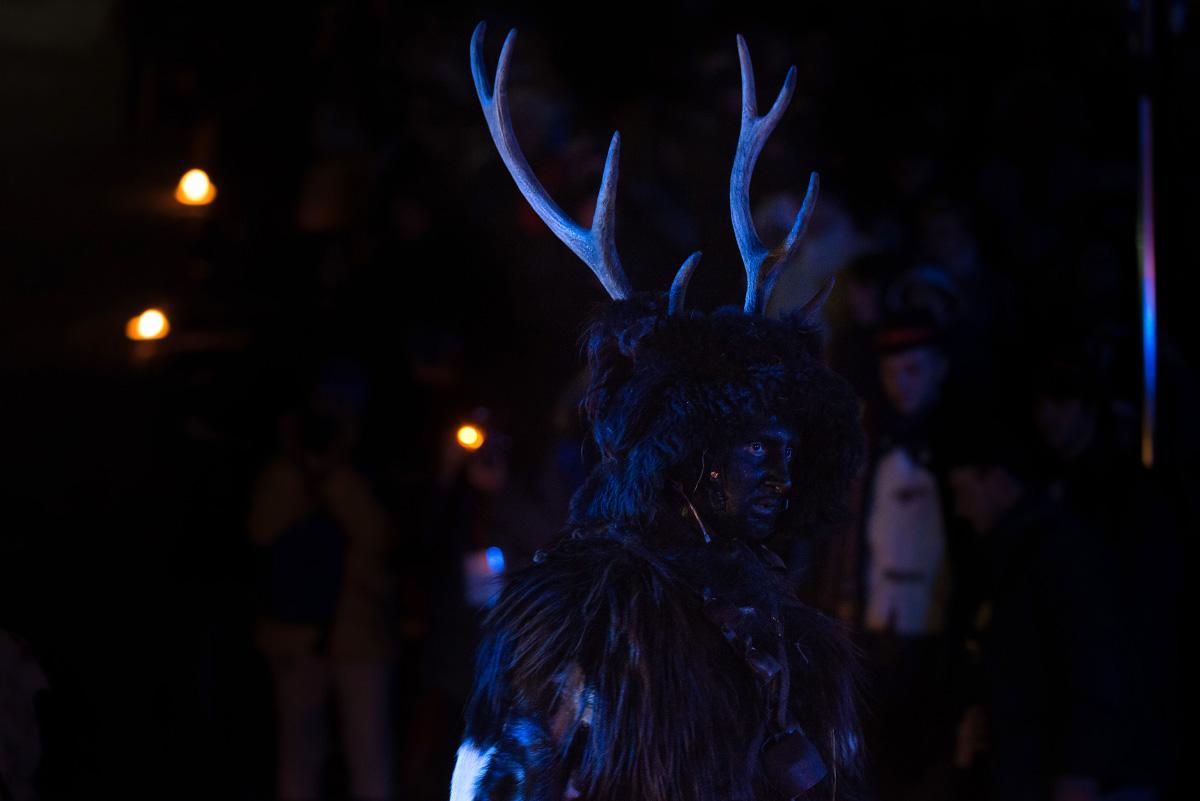
The mask of the deer man, Gl’ Cierv’, a carnival rite from Castelnuovo al Volturno, in the province of Isernia. In the folklore of many Italian regions, wild and ferocious masked figures similar to animals (including bears) in their appearance and movements are very common during carnival.
But the festivities didn’t end at the beginning of February. They continued until the middle of the month with the carnival, with the bear as one of the main characters in some areas of the Alps and central-southern Italy. In some regions in the past, a real trained bear was taken around and made to dance by a bear tamer in the village squares. Later, to maintain the tradition, the bear was replaced by a man wearing a mask who was usually tamed at the end of the rituals. It was believed that when bears emerged from their den, and therefore from the depths of the earth, they were resurrected, bringing with them the dead who became part of people’s everyday life during the carnival. And hence the festivals and rituals. In order to communicate with the dead, you had to become at least temporarily one of them and behave as such (attack, frighten, touch, kidnap, be crazy). This is why many of these festivals still have very potent and violent ceremonies and rituals, a way to exorcise death.
Humans and bears have had a long history of closeness and identification, the traits of which are blurred down the millennia.

